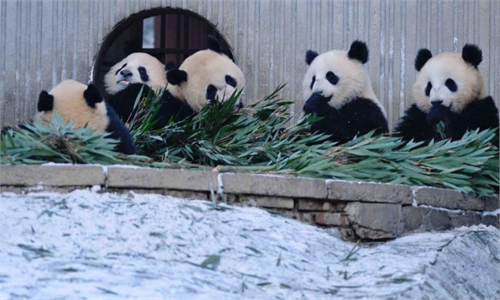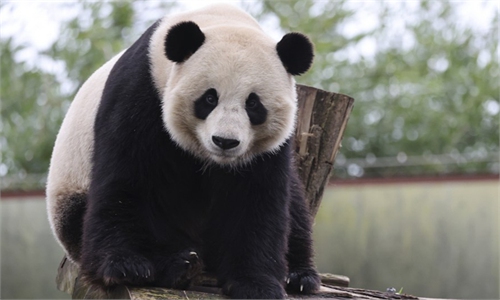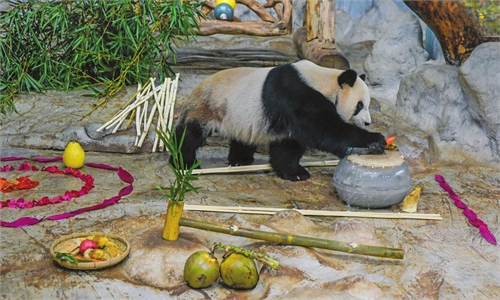IN-DEPTH / IN-DEPTH
Giant panda-lending program widely endeared among animal and peace lovers despite frail voice of politicization
Least-possible demon
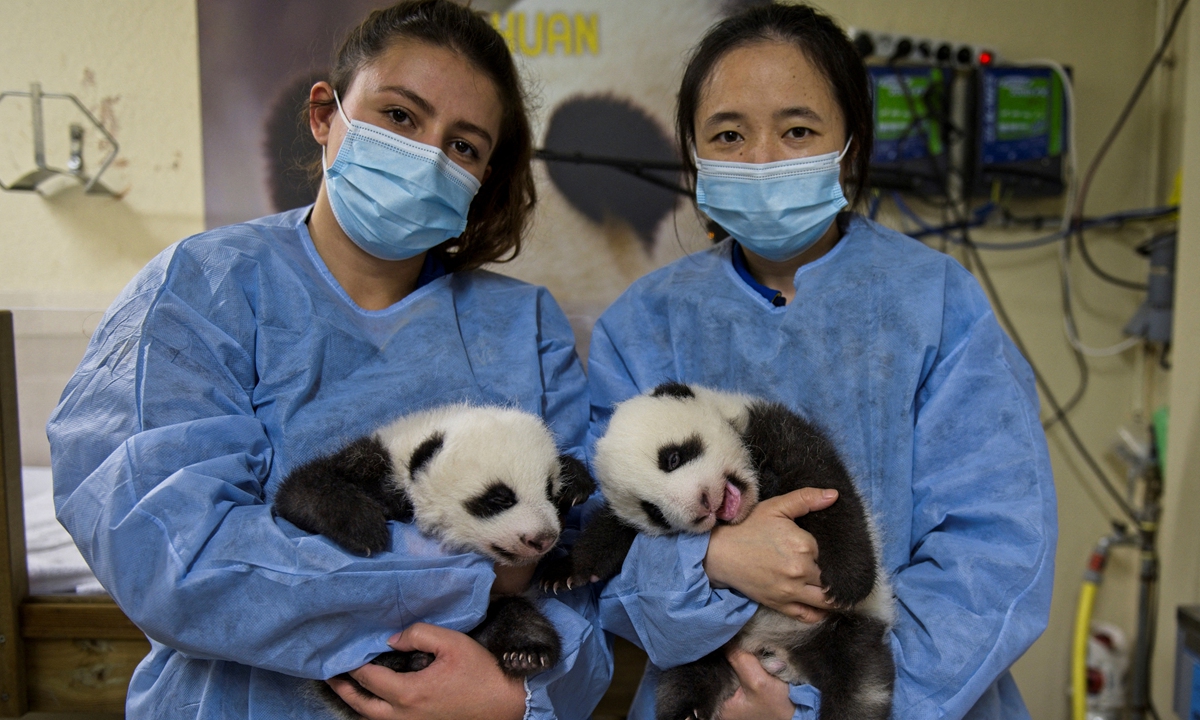
French and Chinese caretakers hold two panda cub twins at the Beauval Zoo in France on September 30, 2021. Photo: AFP
Fifty years ago this month, the cute giant panda became an ice-breaking mascot in the relationship between China and the US as former US president Richard Nixon received a promise in Beijing that two pandas would be sent to the US. But unfortunately, 50 years later, while many people look back on this warm historical footnote, some short-sighted American politicians are demonizing the giant panda and China's friendly gesture of offering the bear to other countries' animal research institutions and animal lovers.US Republican congresswoman Nancy Mace said she planned to proceed with a shocking bill to break the deal made between China and the US and stop the shipment of giant pandas born in the US back to China, asserting that giant pandas should not be used as"window dressing."
Was the overseas trip of the giant panda as a symbol of peace and friendship really just a bit of flashy window dressing?
With the current conducting of collaborative research on giant panda conservation between China and 22 zoos in 18 foreign countries, the Global Times contacted four zoos in different countries that are working closely with China in this field, all of them appreciated the process and the results of their cooperation with their Chinese counterparts.
"The panda is a living fossil, the joint research on giant panda conservation is a symbol of people-to-people exchanges, scientific research, and biodiversity conservation between China and other countries, which has always been valued and taken seriously by all parties,"Zhu Wei, vice director of the Communication Law Research Center at the China University of Political Science and Law, told the Global Times.
In the past, exchanges related to giant pandas have demonstrated the wisdom of the Chinese government and private institutions in developing foreign relations, Zhu said, noting that the current giant panda "on-loan" practice has already been a huge impetus for global scientific cooperation to protect this precious species shared by humanity.
Strict approval procedures
The so-called panda diplomacy has been hyped by some Western media that implied China has ulterior political purposes, but the truth is that it has never been a simple matter for China to send pandas abroad. China has never used, given, or loaned pandas simply as some sort of a bargaining chip, as some Western media outlets have claimed, Chinese experts on panda-breeding and protection told the Global Times.
Since the founding of the People's Republic of China in 1949, China has given a total of 23 giant pandas to nine countries as a token of friendship and goodwill. However, due to the scarcity of the species and the need for better protection of the giant pandas, since 1982, the Chinese government put an end to the "give-away" policy, and from then on, joint exchange and cooperation between animal protection and research facilities in both countries became the only way for giant pandas to travel overseas and live there for a period of time.
The pandas are then offered on loan usually on a cooperative research term from China to some countries, during which any resultant offspring from breeding efforts would be owned by China.
China Wildlife Conservation Association (CWCA) and the Chinese Association of Zoological Gardens are responsible for the programs of sending pandas abroad once they receive applications from overseas institutes.
"Giant pandas are China's national treasures. In order to create a safe and healthy living environment for them, the housing conditions, food supply, and medical research conditions of the giant pandas are indispensable, and they need to be assessed and accepted by experts before they can be sent out," said Wei Rongping, head of Dujiangyan Qingcheng Mountain Base of China Conservation and Research Center for Giant Panda, in Southwest China's Sichuan Province, one of the main research bases that sends giant pandas abroad.
Wei pointed out that overseas zoos need to meet several conditions to carry out giant panda research cooperation with China and acquire pandas on loan from China: First, the site of the giant panda enclosure needs to have suitable climatic and environmental conditions; second, high-security pavilions need to be planned for the panda; third, the food for giant pandas is fresh bamboo, an adult giant panda needs about 40 kg of bamboo supply a day, so it needs to have conditions to offer sufficient supply of bamboo; and finally, there must be a professional giant panda feeding and management team.
According to Wei, the base will communicate with foreign parties in accordance with procedures after receiving international research cooperation tasks on giant pandas. The partner countries will provide two or three alternative sites for the designation of the panda pavilion. Chinese experts will comprehensively evaluate the design scheme and provide technical support during the construction process, and carry out assessments and approval after completion.
At the same time, the CWCA will continue to follow up on the panda's life overseas and actively provide assistance when problems arise.
On January 5, 2020, for example, the CWCA sent a formal letter to South Korea's Everland Zoo after the zoo violated the professional requirements for the protection of giant pandas as it organized performance-related personnel to have close contact with giant panda cubs and produced entertainment programs, requesting the zoo to immediately stop such activates, stop broadcasting or distributing the videos, and further strengthen scientific rigor.
Close scientific cooperation
Chinese experts on giant pandas and zoo staff overseas told the Global Times that collaborative research on pandas has always been a professional issue. Although these giant pandas have traveled far, Chinese research centers will not leave them unattended after their departure. The zoos in foreign countries that host the pandas have also valued the opportunity, and the research results have been very fruitful.
"We have nothing but success with our giant panda program," a spokeswoman for the Smithsonian's National Zoo in Washington DC said in a statement given to South Carolina news outlet The Post and Courier of Charleston, responding to Mace's ludicrous initiative.
According to the zoo, the collaboration with China in panda research has given the zoo an "unparalleled opportunity" to study the behavior, health, and reproduction of giant pandas, which has helped the zoo become a leader in the field of giant panda conservation research.
Dan Ashe, president and chief executive of the US Association of Zoos and Aquariums, also expressed his disapproval of Mace's bill. "This legislation would risk ending a longstanding program that has contributed to the conservation of wild pandas," he said.
In addition to Nixon's visit to China that brought Ling Ling and Hsing Hsing to the US in 1972, on December 6, 2000, giant pandas Mei Xiang and Tian Tian arrived at the Smithsonian's National Zoo through the signing of the Giant Panda Cooperative Research and Breeding Agreement between the zoo and China's CWCA, which was then renewed on December 7, 2020 that stipulates the giant pandas will continue to live in the Zoo through 2023.
In exchange, the zoo contributes funds and expertise toward conservation efforts in China. For instant, US entrepreneur David M. Rubenstein has donated a total of $12 million in support of the zoo's giant panda conservation program, funds that support conservation efforts in China, including research on restoring giant panda habitats, monitoring wildlife diseases, and public education about the species and its conservation.
A staffer surnamed Ito at Ueno Zoological Gardens in Japan told the Global Times via email that Chinese experts will come to the zoo to specifically teach on how to feed and raise giant pandas, how to take care of a pregnant panda to ensure the safe birth of the cub, and other technical aspects.
"We will concretely report the situation of the giant panda in estrus to the Chinese side. The Chinese experts came to our zoo when the baby pandas were born in 2012 and 2017 and stayed for several months to help take care of them on the spot. Although they were not able to come to Japan because of the COVID-19 pandemic, when Xiao Xiao and Lei Lei were born in 2021, the two sides formed a mechanism where Chinese experts could answer questions from the zoo online at any time of the day," said Ito.
Ito noted that the Japanese and Chinese sides share many data with each other to promote the study on giant panda protection and have achieved fruitful results on panda breeding. Since giant pandas Li Li and Zhen Zhen came to the Ueno in 2011, four baby pandas have been born in zoo, which once became a hot topic in Japanese society, Ito said.
In Germany, Philine Hachmeister, deputy head of communication and marketing at Berlin Zoo told the Global Times that their zoo staff is also working closely with Chinese counterparts to protect giant pandas. There are monthly updates on the general health of the giant pandas and a spontaneous exchange of information on any situation that may arise.
Hachmeister pointed out that the lending of two giant pandas paid for by the Berlin Zoo to China has been used to fund the work of Chinese scientists, adding that the Berlin Zoo's panda-related profits are also 100 percent used to support the excellent work of Chinese scientists in breeding, conservation, and reintroduction of giant pandas to their natural habitats.
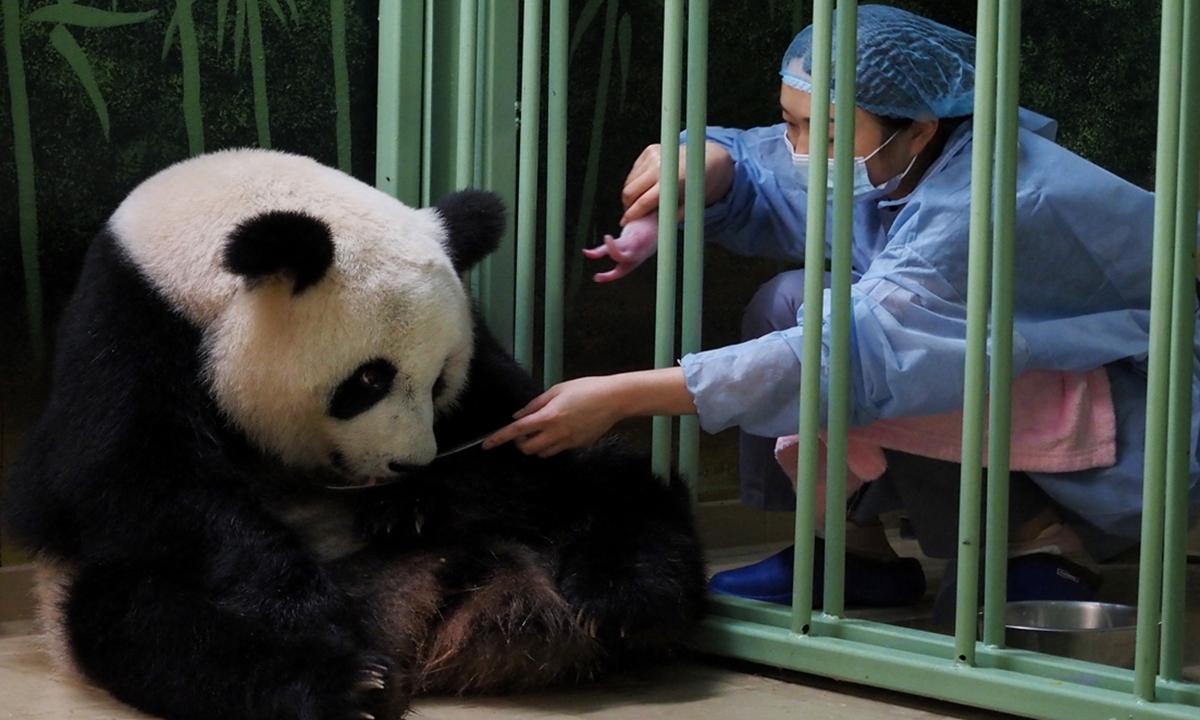
A Chinese caretaker handles a cub after the female panda Huan Huan, which means "Happy" in Chinese, gave birth at the Beauval Zoo on August 2, 2021.
In an interview with the Global Times, staff member at France's Beauval Zoo said that their Beauval Nature Association has actively been working with China on joint research on giant panda conservation since the arrival of the pandas in 2012. They were also grateful that two caretakers from the Chengdu breeding center went to Beauval to care for giant panda Huan Huan's babies during their first months.Connecting people with nature
"Over the years, when I have guided visitors to the Smithsonian's National Zoo, I've seen a lot of elderly people telling their grandchildren the story of their first encounter with giant pandas and the amazing China they've learned about," Sophia Tsou, a tour guide who has been working at Washington for 18 years, told Global Times.
Many Americans will never forget that in April 1972, giant pandas Ling Ling and Hsing Hsing arrived in Washington to be greeted in the rain by 8,000 American spectators. More than one million people visited the panda house in the first month of its opening.
The arrival of giant pandas brings far more than scientific value to the various countries that host them.
"Since their arrival, the pandas have symbolized cross-cultural collaboration between the US and China," the Smithsonian's National Zoo says in a description of the giant panda program on its website.
The lively scene of many visitors in the panda house is still played out at the zoo today.
After taking thousands of visitors to the zoo to see giant pandas over the years, Sophia said she also got to know many giant panda lovers. "Some of them have become panda bloggers on social media, stay in the panda house for long periods of time to take photos, and share the cuteness of pandas with more people," she said.
The staff of Beauval Zoo also described the arrival of giant pandas as a "great story between China and France."
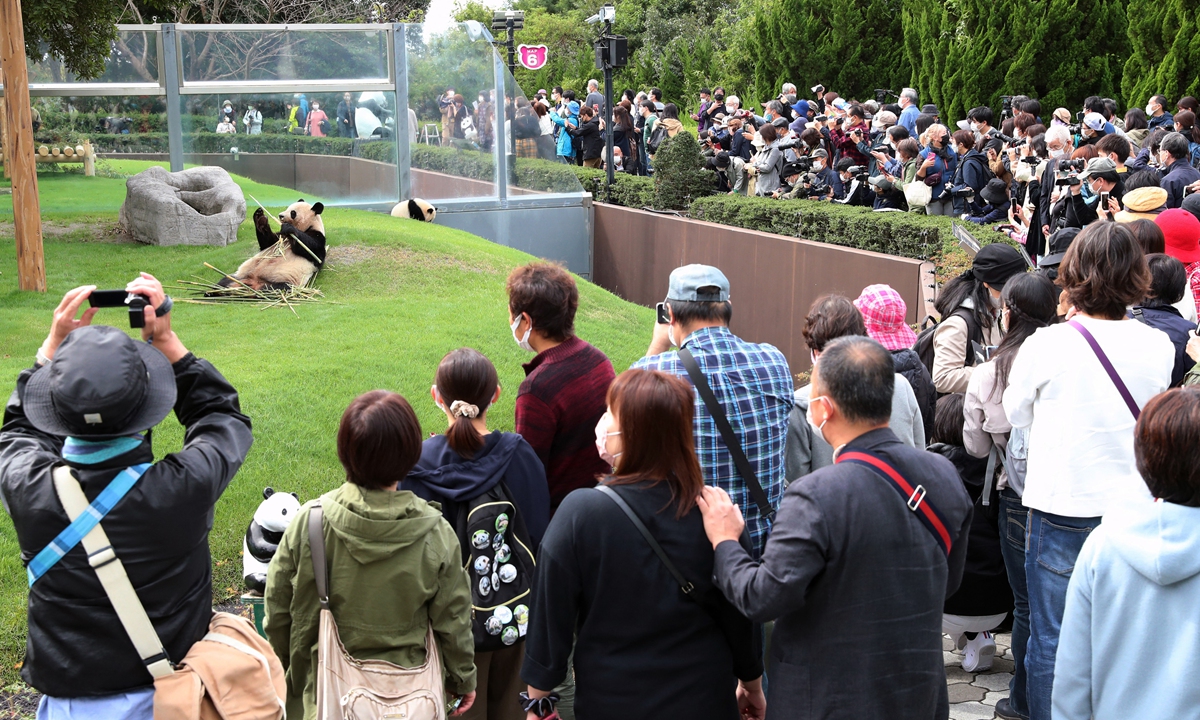
People gather to watch giant pandas at an outdoor enclosure for the first time after the COVID-19 outbreak at Adventure World in Shirahama Town in Japan on October 21,2021. Photo: AFP
At the same time, in an email response to the Global Times, Edinburgh Zoo also noted that the two giant pandas Yang Guang and Tian Tian in Edinburgh have played a critically important role in connecting people with nature and encourage behavior change is invaluable.Edinburgh Zoo noted that as a result of China's conservation efforts, the status of giant pandas in the wild has been moved by the International Union for Conservation of Nature from endangered to vulnerable, which is "encouraging." In order to meet the challenge of more panda conservation, Edinburgh Zoo will continue to donate substantial funds to support this work.
Sending rare animals to show goodwill is one of the most important ways of friendly exchanges among Asian civilizations. It has existed since ancient times. For example, China sent pandas to Japan in the Tang Dynasty, and other countries also sent lions and giraffes to China in the past, Zhu noted.
"Some foreign media outlets deliberately elevated such interactions to solely a political act, and misrepresented such friendly exchanges and scientific cooperation as predicated on political considerations, which is unnecessary,"Zhu said.
